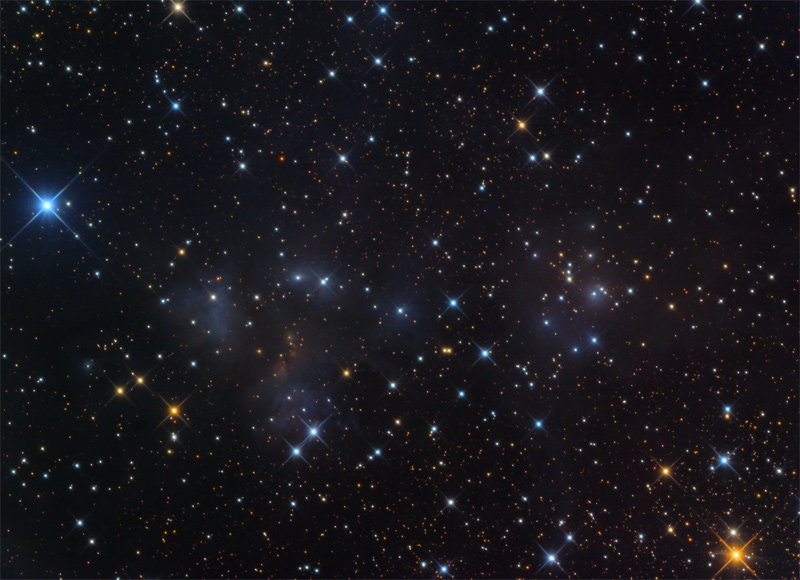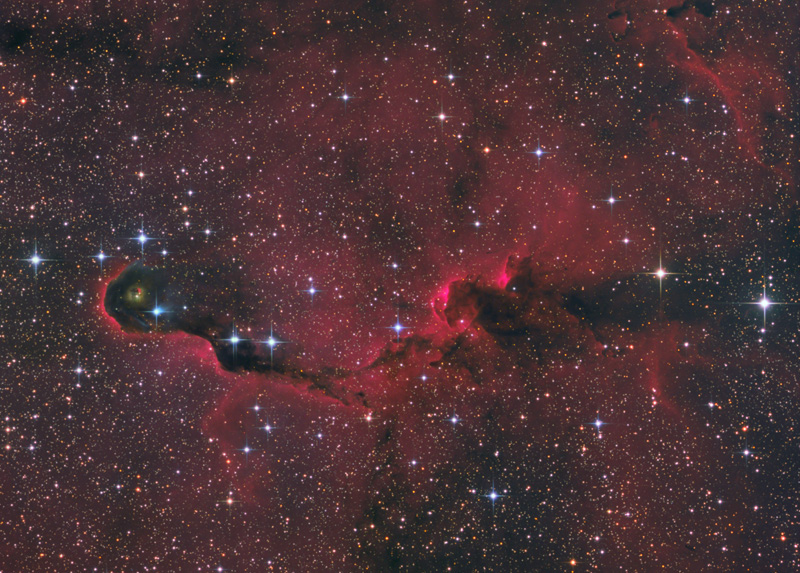Page 2 of 2
ESO: The Sentinel
Posted: Mon Jul 20, 2015 3:00 pm
by bystander
The Sentinel
ESO Picture of the Week | 2015 Jul 20
Here we see the now-obsolete Swedish–ESO Submillimetre Telescope (
SEST), watching vigilantly over the horizon at
ESO’s La Silla Observatory like a sentinel. Below, stratus clouds blanket the valley.
SEST was installed at La Silla in 1987, and at the time of its first light was the only large submillimetre telescope operating in the southern hemisphere. Although it was decommissioned in 2003, the 15-metre diameter dish remains at La Silla Observatory and serves as a tribute to the groundbreaking work it accomplished — both as a standalone telescope, and also as a testbed for later projects such as the Atacama Pathfinder Experiment telescope (
APEX) and the Atacama Large Millimeter/submillimeter Array (
ALMA).
During its tenure, SEST made several big
discoveries, including, in 1995, finding the Boomerang Nebula to be the
coldest place in the Universe at just one degree above absolute zero, and discovering the first
extragalactic silicon monoxide maser.
This beautiful panorama was taken by
ESO photo ambassador Alexandre Santerne. Alexandre is a professional astronomer who also participates regularly in public outreach events and conferences.
Re: Found Images: 2015 July
Posted: Mon Jul 20, 2015 3:55 pm
by starsurfer
vdBH15
http://www.astrophoton.com/vdbh15.htm
Copyright: CEDIC
Processing: Herbert Walter
Re: Found Images: 2015 July
Posted: Tue Jul 21, 2015 4:16 pm
by starsurfer
Re: Found Images: 2015 July
Posted: Wed Jul 22, 2015 1:28 pm
by starsurfer
Re: Found Images: 2015 July
Posted: Sat Jul 25, 2015 1:32 pm
by starsurfer
HH 46-7
http://www.noao.edu/news/2015/soar-hh.php
Copyright: C. Briceño, S. Heathcote & CTIO/SOAR/AURA/NSF
Re: Found Images: 2015 July
Posted: Sun Jul 26, 2015 4:56 pm
by starsurfer
HEIC: The Long Goodbye (NGC 6565)
Posted: Mon Jul 27, 2015 4:06 pm
by bystander
The Long Goodbye (NGC 6565)
ESA Hubble Picture of the Week | 2015 July 27
A dying star’s final moments are captured in this image from the NASA/ESA Hubble Space Telescope. The death throes of this star may only last mere moments on a cosmological timescale, but this star’s demise is still quite lengthy by our standards, lasting tens of thousands of years!
The star’s agony has culminated in a wonderful
planetary nebula known as
NGC 6565, a cloud of gas that was ejected from the star after strong
stellar winds pushed the star’s outer layers away into space. Once enough material was ejected, the star’s luminous core was exposed and it began to produce ultraviolet radiation, exciting the surrounding gas to varying degrees and causing it to radiate in an attractive array of colours. These same colours can be seen in the famous and impressive Ring Nebula (
heic1310), a prominent example of a nebula like this one.
Planetary nebulae are illuminated for around 10 000 years before the central star begins to cool and shrink to become a
white dwarf. When this happens, the star’s light drastically diminishes and ceases to excite the surrounding gas, so the nebula fades from view. ...
Re: Found Images: 2015 July
Posted: Mon Jul 27, 2015 5:39 pm
by starsurfer
Re: Found Images: 2015 July
Posted: Tue Jul 28, 2015 4:04 pm
by starsurfer
Re: Found Images: 2015 July
Posted: Thu Jul 30, 2015 12:31 pm
by gustav
I found this remarkable image by Kfir Simon:
Please see the Comet at the upper left side...
http://www.pbase.com/tango33/image/160830033/original

Re: Found Images: 2015 July
Posted: Thu Jul 30, 2015 6:05 pm
by starsurfer
HEIC: Stormy Seas in Sagittarius
Posted: Thu Jul 30, 2015 8:34 pm
by bystander
Stormy Seas in Sagittarius
ESA Hubble Photo Release | 2015 July 30
Some of the most breathtaking views in the Universe are created by nebulae — hot, glowing clouds of gas. This new NASA/ESA Hubble Space Telescope image shows the centre of the Lagoon Nebula, an object with a deceptively tranquil name. The region is filled with intense winds from hot stars, churning funnels of gas, and energetic star formation, all embedded within an intricate haze of gas and pitch-dark dust.
Nebulae are often named based on their key characteristics — particularly beautiful examples include the Ring Nebula (
heic1310), the Horsehead Nebula (
heic1307) and the Butterfly Nebula (
heic0910). This new NASA/ESA Hubble Space Telescope image shows the centre of the
Lagoon Nebula, otherwise known as Messier 8, in the constellation of
Sagittarius (
The Archer).
The inspiration for this nebula’s name may not be immediately obvious — this is because the image captures only the very heart of the nebula. The Lagoon Nebula’s name becomes much clearer in a wider field view (
opo0417i) when the broad, lagoon-shaped dust lane that crosses the glowing gas of the nebula can be made out.
Another clear difference between this new image and others is that this image combines both
infrared and optical light rather than being purely optical (
heic1015). Infrared light cuts through thick, obscuring patches of dust and gas, revealing the more intricate structures underneath and producing a completely different landscape
[1].
However, even in visible light, the tranquil name remains misleading as the region is packed full of violent phenomena.
The bright star embedded in dark clouds at the centre of this image is known as
Herschel 36. This star is responsible for sculpting the surrounding cloud, stripping away material and influencing its shape. Herschel 36 is the main source of
ionising radiation [2] for this part of the Lagoon Nebula.
This central part of the Lagoon Nebula contains two main structures of gas and dust connected by wispy twisters, visible in the middle third of this image (
opo9638). These features are quite similar to their namesakes on Earth — they are thought to be wrapped up into their funnel-like shapes by temperature differences between the hot surface and cold interior of the clouds. The nebula is also actively forming new stars, and energetic winds from these newborns may contribute to creating the twisters.
This image combines images taken using optical and infrared light gathered by Hubble’s
Wide Field Planetary Camera 2.
Re: Found Images: 2015 July
Posted: Fri Jul 31, 2015 1:43 am
by geckzilla
I wonder if they were inspired by my version of this dataset. I guess I can't say for sure since I'm not mentioned.
Re: Found Images: 2015 July
Posted: Fri Jul 31, 2015 5:03 am
by bystander
Give us a link to your version.
Re: Found Images: 2015 July
Posted: Fri Jul 31, 2015 5:49 am
by geckzilla
Re: Found Images: 2015 July
Posted: Fri Jul 31, 2015 8:22 am
by Ann
The image posted here sure looks a lot like yours.
I browsed your photo stream a bit, too. That's really very nice!
Ann
Re: Found Images: 2015 July
Posted: Fri Jul 31, 2015 5:18 pm
by starsurfer
Ann wrote:
The image posted here sure looks a lot like yours.
I browsed your photo stream a bit, too. That's really very nice!
Ann
I think geckzilla's version is better, looks like more small scale structure is apparent.
Re: Found Images: 2015 July
Posted: Fri Jul 31, 2015 5:22 pm
by starsurfer
NGC 6802
http://www.astro-koop.de/?attachment_id=1479
Copyright: Stefan Heutz, Wolfgang Ries and Michael Breite


